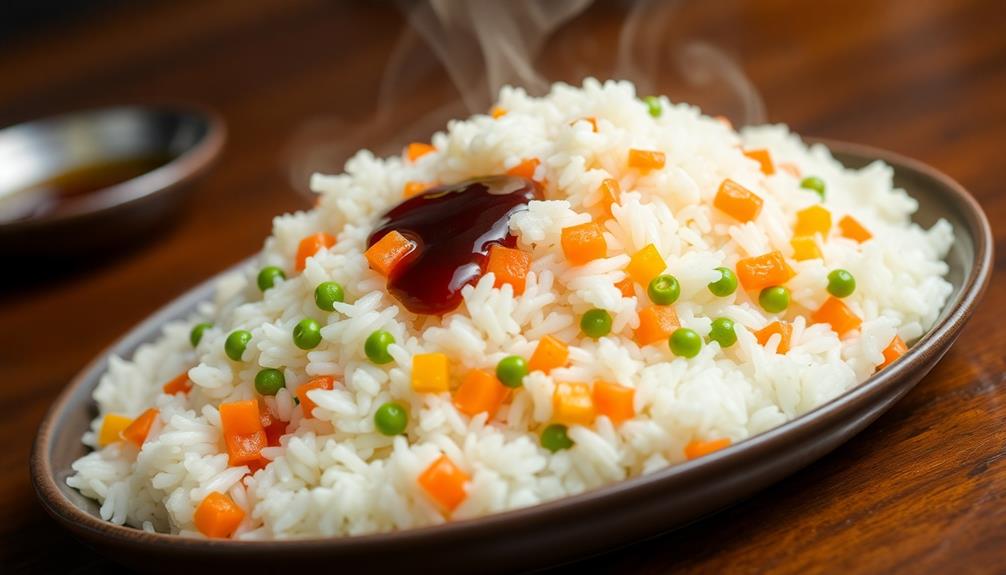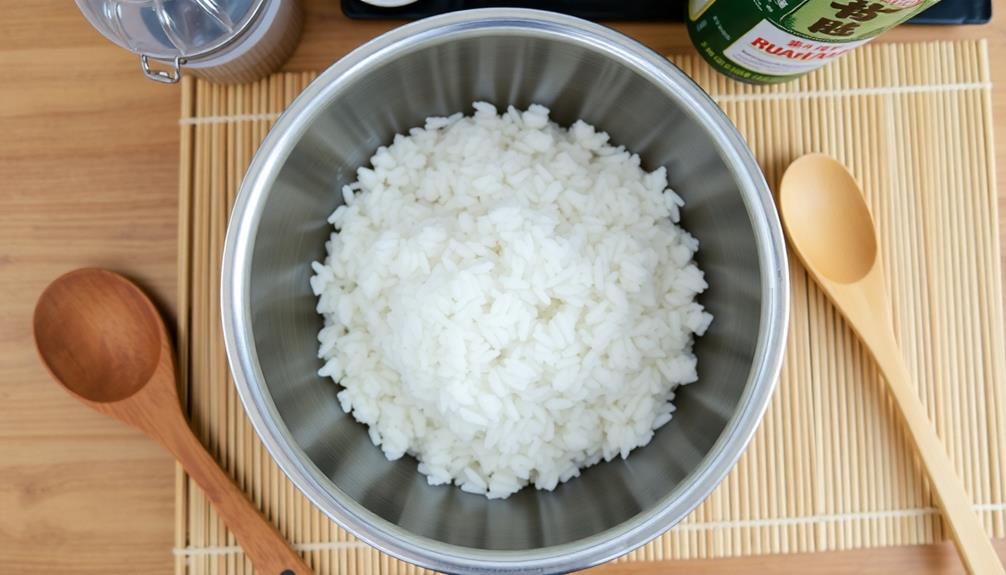You can easily recreate that beloved restaurant-style fried rice right at home. The key is using day-old, chilled rice for the perfect texture. Start by scrambling eggs, then sauté veggies in hot oil. Add the rice and soy sauce, stirring to combine. The trick is avoiding overcrowding the wok for evenly cooked, crispy results. Customize the dish with your favorite proteins or spices. And don't forget the garnishes like green onions or sesame seeds – a small touch that elevates the whole experience. With the right techniques, you'll be serving up fried rice that rivals your favorite takeout. Let's dive deeper into mastering this classic dish. To pair with your perfect fried rice, consider learning how to make fried chicken for an unbeatable combination. The crispy, flavorful chicken adds a hearty element that balances the savory rice beautifully. By mastering both dishes, you’ll be able to create a restaurant-quality meal right in your own kitchen.
Key Takeaways
- Use cold, day-old rice to achieve the ideal texture for restaurant-style fried rice.
- Stir-fry the vegetables quickly to maintain a tender-crisp texture.
- Scramble the eggs separately to ensure fluffiness and incorporate them into the dish.
- Adjust the amount of soy sauce to achieve the desired saltiness.
- Garnish the fried rice with chopped green onions or sesame seeds for added flavor.
History

Fried rice has long been a staple in Asian cuisines, with its origins traced back to the Han Dynasty in China. It was a practical way to repurpose leftover rice, vegetables, and meat, creating a flavorful and filling dish.
Over the centuries, fried rice evolved as it spread across the region, with each culture adding its own unique spin.
In the 19th century, Chinese immigrants brought fried rice to the United States, where it quickly became a popular menu item in Americanized Chinese restaurants.
These establishments perfected the technique, ensuring every grain of rice was separated and cooked to a delightful texture. The addition of soy sauce, scrambled eggs, and an array of vegetables and proteins transformed fried rice into the beloved "restaurant-style" version we know today. The balance of flavors and textures in this dish quickly made it a staple across various cuisines, appealing to a wide audience. From casual diners to high-end restaurants, fried rice continually evolved, incorporating regional ingredients and seasonings. Meanwhile, creative chefs also found innovative uses for rice in desserts, such as crafting rice crispy treats for kids, blending the versatility of this humble grain into sweet confections that are cherished by all ages. This versatility highlights rice’s ability to transcend cultural boundaries, adapting seamlessly from savory dishes to sweet creations. The rise in popularity of desserts like rice crispy treats has inspired home cooks and professionals alike to experiment with their own versions, often seeking the perfect rice crispy treats recipe to achieve that nostalgic flavor and texture. Whether as a comforting side dish or a delightful dessert, rice continues to hold a special place in culinary traditions worldwide.
Recipe
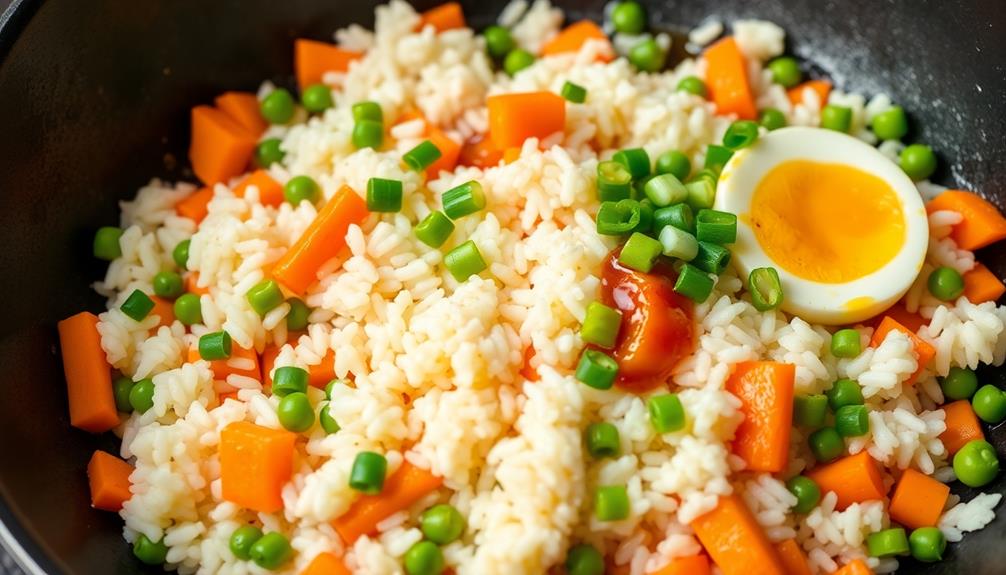
Fried rice is a classic Chinese dish that's a staple in many households and restaurants. When done right, it can be a flavorful and satisfying meal. The key to achieving that signature restaurant-style fried rice is to use the right techniques and ingredients.
First and foremost, it's important to use day-old, chilled rice. Freshly cooked rice is too moist and will result in a mushy, clumped-up fried rice. The drier, cooler texture of day-old rice is essential for achieving the perfect texture.
Ingredients:
- 2 cups cooked and chilled long-grain rice
- 2 tablespoons vegetable oil
- 2 eggs, lightly beaten
- 1 cup diced onion
- 1 cup diced carrots
- 1 cup frozen peas
- 2 cloves garlic, minced
- 2 tablespoons soy sauce
- 1 teaspoon sesame oil
- Salt and white pepper to taste
In a large wok or skillet, heat the vegetable oil over high heat. Add the beaten eggs and scramble them, breaking them up into small pieces as they cook. Remove the eggs from the wok and set them aside.
Add the onions, carrots, and garlic to the wok and stir-fry until the vegetables are tender-crisp, about 3-4 minutes. Add the chilled rice, soy sauce, and sesame oil, and continue to stir-fry until the rice is heated through and all the flavors are combined, about 5-7 minutes.
Finally, stir in the scrambled eggs and the frozen peas, and cook for an additional 2-3 minutes until everything is heated through. Season with salt and white pepper to taste.
To ensure your fried rice turns out perfectly, resist the urge to overcrowd the wok or skillet. Work in batches if needed, and make sure the wok or skillet is ripping hot before adding the ingredients. This will help create that signature wok-hei flavor and prevent the rice from becoming soggy.
Cooking Steps

First, cook the rice according to the package instructions.
Then, scramble the eggs in a hot, oiled skillet.
Next, stir-fry the vegetables in a wok until tender.
Step 1. Cook Rice According to Package
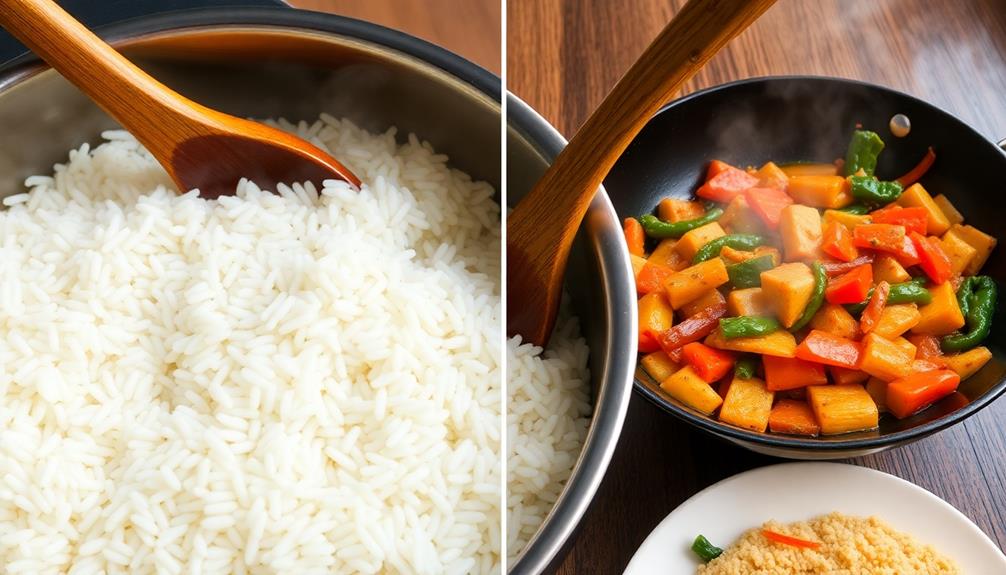
Before you begin preparing the other ingredients, cook the rice according to the package instructions. This is a crucial first step, as the rice needs to be cooked and cooled before it can be fried.
Follow the directions on the rice package carefully. Typically, this involves bringing a pot of water to a boil, adding the rice, and then simmering for the recommended time, usually 15-20 minutes. Be sure to use the correct rice-to-water ratio, as specified on the package.
Once the rice is cooked, fluff it with a fork and spread it out on a baking sheet or plate to allow it to cool completely.
This step is important, as you don't want to fry warm or hot rice, as it can lead to a soggy texture. Take the time to let the rice cool before proceeding with the rest of the fried rice preparation.
Step 2. Scramble Eggs in Hot Oil

With the rice now cooled, you'll want to scramble the eggs in hot oil. This is a crucial step in achieving that authentic restaurant-style fried rice flavor and texture.
Start by heating a large skillet or wok over medium-high heat. Once the pan is hot, add a tablespoon or two of oil – something with a high smoke point like vegetable or peanut oil works best.
Using the right oil can also enhance the overall aroma of the dish, similar to how various brewing methods affect caffeine content significantly.
Crack 2-3 eggs directly into the pan and use a spatula to quickly scramble them, breaking them up into small pieces as they cook. Be sure to move the eggs around constantly, ensuring they cook evenly and don't stick to the pan. This should only take about a minute or two.
Once the eggs are fully cooked and fluffy, transfer them to a plate or bowl and set them aside. This precooked egg will get mixed back into the fried rice later, adding both flavor and texture.
With the eggs scrambled, you're now ready to start building your restaurant-style fried rice!
Step 3. Stir-Fry Vegetables in Wok
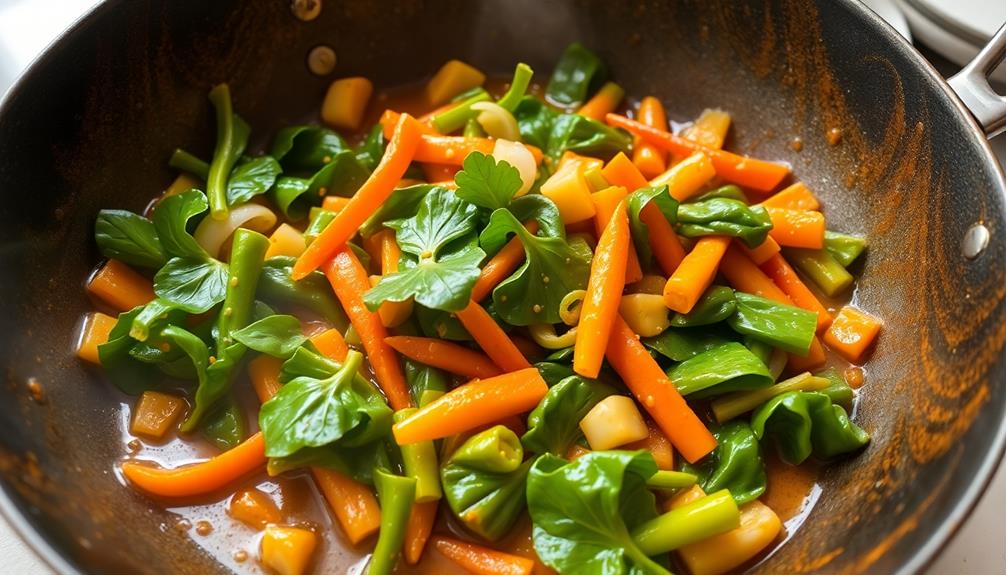
Next, heat the same wok or large skillet over high heat.
Once it's blazing hot, add a couple tablespoons of oil – you want enough to coat the surface and allow the vegetables to sizzle.
Toss in your prepped veggies. Stir-fry for 2-3 minutes, keeping everything moving constantly. You want the vegetables to remain crisp-tender – they'll continue cooking in the residual heat.
- Add the harder veggies like carrots or broccoli stems first, then follow with softer ones like bell peppers or mushrooms.
- Season with a pinch of salt and pepper. Garlic, ginger, or other aromatics can also be added at this stage.
Once the vegetables are just shy of your desired doneness, add the cooked eggs from earlier. Toss everything together for another minute to heat through.
The wok should remain over high heat the entire time to ensure the vegetables cook quickly and develop a nice char.
Step 4. Add Soy Sauce and Seasonings

Drizzle in a few tablespoons of soy sauce and a dash of sesame oil. This adds a savory, umami flavor and a subtle nuttiness to the fried rice.
Next, sprinkle in a pinch of white pepper and a teaspoon of garlic powder. The white pepper provides a gentle heat, while the garlic powder enhances the overall aroma.
If you'd like to make the dish a bit sweeter, stir in a teaspoon of brown sugar. This balances out the saltiness of the soy sauce. If you’d like to make the dish a bit sweeter, stir in a teaspoon of brown sugar. This balances out the saltiness of the soy sauce. For an extra touch, consider adding a splash of orange juice or a pinch of cinnamon to give it a unique twist reminiscent of a Sunday brunch in Florence. The warm, subtle sweetness will elevate the dish and make it perfect for sharing with loved ones.
For an extra punch of flavor, consider adding a splash of Worcestershire sauce or a few dashes of fish sauce. These ingredients lend a complex, salty-sweet profile.
Step 5. Add Cooked Rice to Wok

Once the seasonings have been added, add the cooked rice to the wok. You'll want to use rice that's been previously cooked and cooled, as freshly cooked rice can make the fried rice turn out mushy.
Gently fold the rice into the veggie and egg mixture, using a spatula to break up any clumps. It's important to work quickly and avoid overcrowding the wok – you may need to do this in batches depending on the size of your wok.
As the rice heats through, it'll start to separate and fry up nicely. Stir-fry for 2-3 minutes until the rice is heated and has a nice, slightly crunchy texture.
Be careful not to overstir, as that can lead to mushy rice. Taste and adjust seasonings as needed, adding a splash more soy sauce if desired. The goal is to get that authentic restaurant-style fried rice texture and flavor.
Final Thoughts

Creating restaurant-style fried rice at home is a rewarding experience. You've learned the secrets to cooking the rice properly, mastering the wok technique, and selecting the perfect blend of ingredients.
Now, as you sit down to enjoy your homemade creation, you can feel a sense of pride and accomplishment.
The beauty of fried rice is its versatility. You can tailor it to your personal taste preferences, experimenting with different proteins, vegetables, and seasonings.
Don't be afraid to get creative and put your own spin on the dish. The key is to have fun with the process and not get too caught up in achieving perfection.
Frequently Asked Questions
How Can I Make the Rice Extra Fluffy?
To make your rice extra fluffy, rinse it thoroughly before cooking, use a rice cooker, and fluff the grains with a fork as soon as it's done. This will ensure each grain is light and airy.
Can I Use Frozen Vegetables Instead of Fresh?
You can definitely use frozen vegetables instead of fresh ones. Frozen veggies are just as nutritious and convenient, making them a great option for fried rice. Just be sure to thaw and drain them before adding to the dish.
How Do I Get the Perfect Texture on the Rice?
To get the perfect texture on the rice, you'll want to cook it properly. Use long-grain white rice, rinse it thoroughly, and cook it until it's just tender but still firm. Fluff it with a fork before adding to the fried rice.
What Type of Oil Is Best for Frying the Rice?
For frying the rice, you'll want to use an oil with a high smoke point, such as peanut, vegetable, or canola oil. These oils can withstand the high heat needed to get that perfect restaurant-style texture.
Can I Make the Dish Vegan or Gluten-Free?
You can absolutely make this dish vegan or gluten-free. Simply swap out the protein source and use gluten-free soy sauce or tamari. With a few simple substitutions, you can enjoy this tasty fried rice recipe regardless of your dietary needs.
